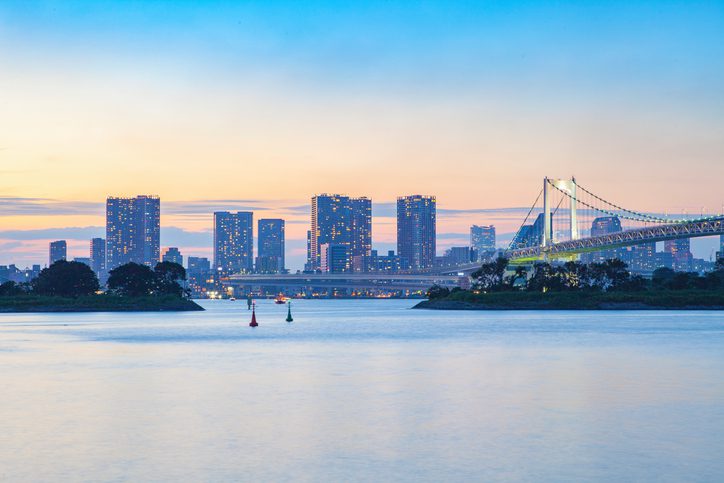Tokyo swim course “smelled like a toilet” two years ago … report indicates that smell is back
World Triathlon tests for last two weeks have all come back within the limits
 Photo by:
Getty Images
Photo by:
Getty Images
According to a story by Bloomberg, “Tokyo’s outdoor swimming venue stinks.”
View this post on Instagram
The story, written by Erica Yokoyama highlights the issues that have plagued the open water swimming venues in Tokyo for a few years. According to phys.org “In October 2017, Tokyo 2020 organisers were left red-faced after tests revealed levels of e-coli bacteria more than 20 times higher than international standards, sparking doubts about the venue’s safety.” Tests done in the harbour in at the Para triathlon test event in 2019 forced World Triathlon to cancel the swim because E. coli levels in the water were twice the limit. The water was so bad that one athlete told Asahi newspaper that the water at the venue “smelled like a toilet.”
According to Yokoyama, the bad smell is back – “despite months of efforts to clean up the water, the bay stinks,” she reports.
The efforts to clean up the water included dumping 22,200 cubic metres of sand into the bay and screens to keep E. coli out of the water. There are also huge storage tanks that have been added to capture runoff from Tokyo’s mixed sewage system.
“The problem is that the world’s largest metropolis doesn’t have separate drainage systems for rainwater and sewage,” Yokoyama reports in her Bloomberg story. “So the waste water and sewage from 30 million residents combined with runoff that feeds seven rivers and dozens of subterranean streams and canals all has to be treated before entering the bay.
“Tokyo suffers from typhoons and other extreme weather which cause floods that can overwhelm the treatment system. To avoid damage from the floodwaters during days of extreme rainfall, untreated sewerage gets flushed directly into the bay.”
Officials estimate it would cost over CDN$115 billion to redo the sewer system and have separate drainage systems – obviously something that’s not likely to happen any time soon.
According to Nikkei Asia, the Tokyo organizers had considered moving the triathlon event to Yokohama, the site of a World Triathlon Championship Series race, “but the idea was shot down by the ITU.” It’s not even certain how much better the water would be there – according to a number of athletes who competed in Yokohama last May the water conditions there were not great, either.
The Olympics in Rio in 2016 were similarly plagued with issues around the water conditions – there was even a report of a human arm found floating near the triathlon and open-water swim venue.
The triathlon events begin on July 26, which doesn’t leave much time for the water conditions to improve, but as we reported in November, 2019, the use of the underwater screens had made a significant difference to the water quality over a 12-day testing period that aligned with the timing for the Olympic and Paralympic events. World Triathlon points out that since then organizers have beefed up the screens, which should help clean things up before race day.
“Tokyo 2020 and World Triathlon have been monitoring the body of water in Odaiba Bay, the venue for Olympic Triathlon, for more than two years,” World Triathlon said in an emailed statement. “For the Test Event, in August 2019, World Triathlon and Tokyo 2020 installed a single-layer screen to prevent contaminated water entering the area where the triathlon and open swimming events were to take place. It was then agreed that for Games time, a triple-layer screen was to be put in place, and this has been operating in the Bay for the last month. The installation of triple-layer screens has proven to be working and all the measurements taken in the area since the triple-layer barriers were installed is within the limits authorised by both World Triathlon and FINA. Tokyo 2020 is conducting a daily test for the last two weeks, with samples taken each day in two different locations of the body of water -one of them inside the barriers, one of them outside- and the results show the underwater screen is working effectively. All results will be available for athletes and coaches to check at the Athlete’s lounge. During Games time, there will be two daily tests, each one taking two samples in different points.”
“Tokyo 2020 is using Tecta – TDS portable laboratory for delivering fast and reliable microbiological water quality tests,” the statement continues. “This portable laboratory, already implemented in the 2019 World Triathlon Olympic Test Event in Tokyo, allows us to obtain results of E-Coli and Enterococci bacteria levels in the body of water tested in less than 12 hours.”
If the water quality is deemed unsafe, World Triathlon also has some back up options:
“World Triathlon and TOCOG have all scenarios contemplated in the contingency plan. All efforts will always be to keep the event as planned, and we have some reserve days that we could potentially use in case of any issues.”
